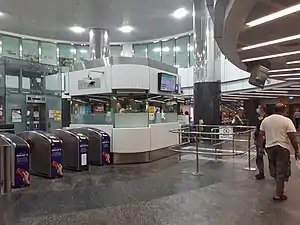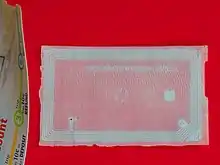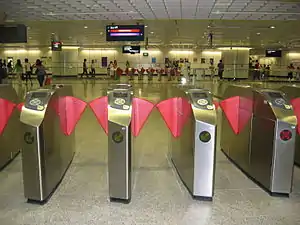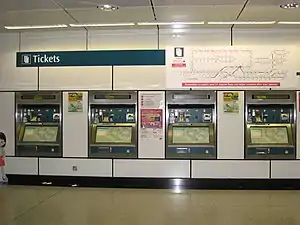Fares and ticketing on the Mass Rapid Transit (Singapore)
Because the rail operators are government-assisted profit-based corporations, fares and ticketing on Singapore's Mass Rapid Transit (MRT) system are currently aimed at least in breaking even to at least compensate for their costs of running the system. The rail operators collect fares by selling electronic tickets capable of storing data, the price of which is calculated based on the distance between the start and destination stations. These prices increase in fixed stages for standard non-concessionary travel. From the information that was earlier written in these tickets, it is possible to increase the fare according to increments based on approximate distances between stations.

Stations on the MRT system are divided into two areas, paid and unpaid areas, which allows the rail operators to collect needed fares by restricting entry only through the fare gates, also known as access control gates. These gates, connected to a computer network, are able to read the electronic tickets, and can store information such as the amount of time taken per trip, and the start and destination stations of each trip. This allows the rail operators to collect fares based on this information.
Fares
Although operated by private companies, the system's fare structure is regulated by the Public Transport Council (PTC), to which the operators submit requests for changes in fares.[1][2] Fares are kept affordable by pegging them approximately to distance-related bus fares, thus encouraging commuters to use the network and reduce heavy reliance on the bus system. A fare review is conducted every year, based on a formula that itself is reviewed every 5 years. The formula takes into account the main factors affecting the cost of operating the public transport system, including the MRT and public buses.[3] Fare increases have caused public concern, but fares are reduced in both 2009, 2010, 2015, 2016 and 2017.[4][5] Historically, fares on the fully underground North East, Circle, and Downtown lines had been higher than those of the North South and East West lines (NSEWL), a disparity that was justified by citing higher costs of operation and maintenance on a completely underground line. However, the Public Transport Council (PTC) announced in 2016 that fares for the three underground lines would be reduced to match those on the NSEWL, which took effect along with the annual fare review, on 30 December 2016.[6][7]
After the opening of Downtown line Stage 3, Transport Minister Khaw Boon Wan announced that public transport fare rules will be reviewed to allow for transfers across MRT lines at different stations due to the increasing density of the rail network. At the time, commuters were charged a second time when they made such transfers. He added that the PTC would review distance-based fare transfer rules to ensure they continue to facilitate "fast, seamless" public transport journeys. The review of distance-based fare rules on MRT lines was completed, and a waiver on the second boarding fee incurred when making such transfers was announced on 22 March 2018. The scheme was implemented on 29 December 2018.[8][9][10]
MRT fares
| Fares (as of 28 December 2019)[11] | |||
|---|---|---|---|
| Adult | Senior citizen / Persons with disabilities | Student1 | Workfare transport Concession |
| $0.92 - $2.17 | $0.59 - $0.92 | $0.42 - $0.63 | $0.68 - $1.72 |
Notes
Children under the age of 4 and below the height of 0.9m travels for free. Children under the age of 7 can travel for free using a child concession card.
1: Only for school smartcards, Diploma Student EZ-Link, and ITE Student EZ-Link Card only. Undergraduates have to pay adult fares, as more than 90% of the undergraduates are eligible voters.
Ticketing
Tickets
Contactless smart cards fully replaced their magnetic ticket predecessors on 1 December 2002, making Singapore one of the first cities to implement contactless smart card payment on all main modes of public transportation, similar to Hong Kong.
The ticketing system uses the EZ-Link and NETS FlashPay contactless smart cards based upon the Symphony for e-Payment (SeP) system for public transit built on the Singapore Standard for Contactless ePurse Application (CEPAS) system. This system permits up to 4 card issuers to provide for the market.[12] The EZ-Link card was introduced on 13 April 2002 as a replacement to the original TransitLink farecard, while its competitor, the NETS FlashPay card, entered the smart card market on 9 October 2009.
Stored-value card
An adult EZ-Link card may be purchased for S$12 (inclusive of a S$5 non-refundable card cost and a S$7 credit) for payment of public transportation fares in Singapore. The card may be purchased at any TransitLink ticket office or passenger service centre. The card may also be used for payment of goods and services at merchants displaying the "EZ-Link" logo, Electronic Road Pricing tolls and Electronic Parking System carparks.[12][13] Additional credit may be purchased at any General Ticketing Machine (GTM), Add Value Machine (AVM), TransitLink Ticket Office, Passenger Service Centre, AXS Station, DBS/POSB Automatic Teller Machine (ATM), online via a card reader purchased separately or selected merchants. Additional credit of a predetermined value may also be automatically purchased whenever the card value is low via an automatic recharge service provided by Interbank GIRO or through a manual application at the TransitLink Ticket Office or credit card online. An option for EZ-Link Season Pass for unlimited travel on buses and trains is available for purchase and is non-transferable.
The NETS FlashPay card may be purchased at all TransitLink Ticket Offices at MRT stations, retail points such as 7-Eleven stores, Cheers and Fairprice Xpress as well as iNETS Kiosks. It can be used for the payment of public transportation fares in Singapore and at merchants displaying the "NETS FlashPay" logo.
Account-based ticketing
On 20 March 2017, LTA started a trial of the usage of contactless debit and credit MasterCard cards for fare payments on all main modes of public transport.[14] Fares are charged directly to their debit or credit cards. From 3 December 2018, the trial was expanded to NETS and Visa cards.[15] On 7 March 2019, the system was renamed to SimplyGo, and it was officially launched on 4 April 2019, starting with MasterCard holders. As of November 2019, Visa and NETS are also able to utilise the system, through usage is encouraged since the COVID-19 social distancing measures, reducing the need to queue at general ticketing machines.[16]
First-generation standard ticket
A standard ticket contactless smart card for single trips may also be purchased between S$2 and S$4 (inclusive of a S$1 refundable card deposit) for the payment of MRT and LRT fares. The card may be only purchased at the GTM. The deposit may also be retrieved by returning the card to the GTM within 30 days from the date of issue or donated to charity by depositing it in a collection box at any station. This card cannot be recharged with additional credit.
Second-generation standard ticket

A paper-based standard ticket contactless smart card for single/return trips may be purchased between S$1.10 and S$7 (inclusive of a S$0.10 refundable card deposit) for the payment of MRT and LRT fares. The card may only be purchased at the GTM. Unlike the first generation Standard Ticket, this second generation Standard Ticket can be recharged with additional credit for up to 6 trips within 30 days from the date of issue. The deposit will be refunded upon recharging the card for the third trip at the GTM. A further S$0.10 rebate will be given upon recharging the card for the sixth and final trip at the GTM. Credit purchased for the single/return trips must be used on the same day of purchase. For commuters who purchased credit for the return trip, but did not return to the original station on the 'return trip', they can top up the fare difference at the destination station if the purchased credit is less than value of the trip. It will no longer be available after 23 November 2018.
Singapore Tourist Pass & 7 Singapore Pass
A Singapore Tourist Pass and 7 Singapore Pass contactless smart card may be purchased from S$10[18] (inclusive of a S$10 refundable card deposit and a 3-day pass) for the payment of public transportation fares including sightseeing bus routes under Singapore Ducktours. The card may be purchased at selected TransitLink Ticket Offices, LTA Kiosks, Passenger Service Centres and Singapore Visitors Centres, and can be refunded at both TransitLink Ticket Offices and Passenger Service Centres.[19]
Access-control gates
Access-control gates found in Singapore's MRT and LRT stations have evolved in design & features over the years. A few different series of gates from different manufacturers have been used in MRT and LRT stations. The two oldest generations of these gates in the MRT stations began to be removed starting from March 2010, and this was completed by October 2014.
On 22 July 2018, a hands-free ticketing technology trial was launched at 4 stations to examine the feasibility of a new hands-free fare gate that allows people with disabilities to enter and exit MRT stations without tapping their fare cards. If found to be feasible, the fare gates may be introduced to more stations. The trial lasted until November 2018.[20] A tender for a second trial was announced in February 2020, with the possibility of expanding the system to all public buses and 400 faregates should the trial be successful.[21]

| Manufacturer/type | Location | Features |
|---|---|---|
| Cubic AFC gates | North South line and East West line stations (replaced by 2014, Pioneer and Joo Koon replaced on 27 June 2017) | Magnetic fare card reader (removed by 2003) CEPAS smart card readers Retractable red flaps VFD fare information displays (Some units equipped with angled VFD displays, some of them are in analogue and some of them are in digital) Bulb-operated directional sign displays Red alarm/concession indicator |
| ST Electronics AFC gates | Expo (East West line) Bedok Kembangan Paya Lebar (East West line) Raffles Place Tanjong Pagar Outram Park (East West line) Dover Orchard (All phased out beginning with Orchard on 10 June 2011, then Bedok, Kembangan, Paya Lebar and Raffles Place in 2014, others were converted between July and November 2017) |
Magnetic fare card reader (removed by 2003) CEPAS smart card readers Retractable red flaps Angled VFD fare information displays LED directional sign displays Red alarm/concession indicator |
| Cronos faregates | Bukit Panjang LRT stations | |
| Cubic AFC turnstile faregates | Bukit Panjang LRT stations (replaced by November 2017) | Magnetic fare card reader (removed by 2003) CEPAS smart card readers Three arms tripod turnstiles Angled VFD fare information displays Bulb-operated directional sign displays |
| Thales AFC gates | North East line stations (except Dhoby Ghaut) Sengkang LRT stations Punggol LRT (East Loop) stations Circle line stations |
CEPAS smart card readers Retractable red flaps (Wide gate feature dual retractable flaps) 6.5" LCD fare information displays LED directional sign displays LED gate status indicators |
| Titan faregates | All North South Line and East West Line stations Dhoby Ghaut (North East line) Bayfront Punggol LRT (West Loop) stations Cheng Lim Kupang Bukit Panjang LRT stations |
CEPAS smart card readers Retractable red flaps Angled LCD fare information displays Illuminated LED directional bar LED gate status indicators Frontal LCD Display (selected units) |
| Thales faregates | All Downtown line stations | CEPAS smart card readers Bidirectional swing flaps 6.5" LCD fare information displays LED directional sign displays LED gate status indicators |
| Cubic AFC gates | All Thomson–East Coast line stations[22] |
Passenger service centres
Passenger service centres are control stations that looks after the station, and handle cash top-ups for all MRT cards. By the first half of 2018, cash top-ups at all passenger service centres were phased out.[23]
Ticketing machines
In the early years, single trip magnetic tickets were purchased at ticket vending machines with coins only. Notes could be broken up into small change at a separate change machine. Those holding magnetic multi trip farecards could only reload their cards with additional credit at manual service counters or a separate add-value machine.
The Add Value Machine originally accepts magnetic farecards, and was upgraded to the EZ-Link cards in 2002. It accepts reload of card credit via NETS only. It was upgraded to Add Value Machine Plus (AVM+) since 2013.
Prior to the standardization of general ticketing machines (GTMs) in 2002, the ticket vending machine also allows pushing button to select fare and accepts coins only. There are also integrated ticketing machines and touch screen ticket vending machine.
The GTMs allows the passenger to top-up stored value cards, . Passengers can also purchase a standard ticket in cash (coins and notes), obtain a refund on their standard ticket deposit, check the value remaining in their EZ-Link Cards and view their past card transactions.

GTMs by Cubic had been installed on all North South and East West line stations since 2002, and Circle line stations since their opening; and by Ascom, on all North East line stations since their opening. Using these machines, to buy a standard ticket, passengers selected a destination station on a touch sensitive rail map, and the fare was automatically calculated. Payment for standard tickets was in cash (coins and notes). Passengers could also top-up their EZ-Link or NETS FlashPay cards by placing it on an external reader, and topping up through NETS.
In 2013, all existing GTMs were upgraded, coinciding with the release of the new Singapore third series coins. With the upgrade, a new touchscreen was introduced, replacing the old rail map format. Passengers buying a standard ticket now select their destination station on the touchscreen, either through a navigational rail map or by station name. A single trip or return trip option is available. This type of GTM accepts EZ-Link/NETS FlashPay card top-ups through contactless credit and debit cards, and contactless e-payment systems, in addition to cash and NETS. Passengers may also apply for the automatic reload service through GIRO or VISA.[24]
All transit ticketing machines will be replaced progressively from 2021 onwards.[25]

See also
References
- Land Transport Authority, Singapore 1996, pp. 58–59.
- "Tricky balance in fare changes". The Straits Times. 17 September 2007. p. 21.
- "Review of transport fare formula needed to reflect rising cost of operating MRT system: Khaw Boon Wan". CNA. 2019-07-08. Retrieved 2020-03-10.
- Yvonne Cheong (14 April 2005). "Public transport fare hike not justified as SMRT still profitable: CASE". Channel NewsAsia. Singapore. Archived from the original on 2 February 2008.
- Christopher Tan (13 September 2008). "Bus and MRT fares to go up from Oct 1". The Straits Times. p. 1.
- "Public transport fares may be standardised". The Straits Times. 10 October 2016. Archived from the original on 6 April 2019. Retrieved 6 April 2019.
- "Public transport fares to fall by 4.2% from Dec 30 due to lower energy prices". CNA. Archived from the original on 6 April 2019. Retrieved 6 April 2019.
- "PTC to review fares incurred when switching between MRT stations, says Khaw". Channel NewsAsia. 22 October 2017. Archived from the original on 23 October 2017.
- Koh, Valerie (20 October 2017). "Review underway to address additional fares when switching between MRT lines: Khaw". TODAY Online. Archived from the original on 23 October 2017.
- "Commuters can exit and re-enter rail system without penalty". The Straits Times. 22 March 2018. Archived from the original on 26 March 2018. Retrieved 11 March 2019.
- "Fare Structure". Public Transport Council. Retrieved 2019-04-06.
- Maria Almenoar (9 January 2009). "Free replacement exercise on till Sept 30". The Straits Times. Archived from the original on 2013-01-05. Retrieved 2009-07-20.
- Imelda Saad (26 August 2008). "New e-payment system and next generation card for public transport". Channel NewsAsia.
- "Joint News Release by the Land Transport Authority (LTA) & Mastercard - LTA Pilots Account-Based Ticketing System for Public Transport with Mastercard | Press Room | Land Transport Authority". www.lta.gov.sg. Archived from the original on 2017-03-25. Retrieved 2017-03-24.
- "LTA expands contactless payment trial to include Visa & NETS in Dec. 2018". Mothership.sg. Retrieved 2019-04-06.
- "Pay for train, bus rides with your Nets card from Nov 16". The Straits Times. 2019-11-08. Retrieved 2020-03-10.
- Zankl, Andreas (March 2014). Security and Privacy in an RFID-based Electronic Payment System. Graz University of Technology. Retrieved 16 September 2019.
- "The Singapore Tourist Pass - The only pass that gives you unlimited rides* on public transport". thesingaporetouristpass.com.sg. Archived from the original on 2017-11-21. Retrieved 2017-11-20.
- "Why Singapore Tourist Pass". Singapore Tourist Pass. Archived from the original on 2013-05-16. Retrieved 2013-06-18.
- "Hands-free fare gates being tried out at four MRT stations". The Straits Times. 2018-06-22. Retrieved 2019-04-06.
- "LTA looks to test hands-free payment on trains, buses". The Straits Times. 2020-02-26. Retrieved 2020-03-10.
- "Cubic Wins $35.5 Million Contract to Supply Fare Collection Equipment for Singapore Land Transport Authority's Future Rail Line". www.cubic.com. 2016-09-15. Retrieved 2020-03-18.
- hermesauto (2018-02-18). "Cash top-up at MRT passenger service centres to be phased out by March". The Straits Times. Retrieved 2020-03-18.
- "e-Payment Top-up at General Ticketing Machines". www.transitlink.com.sg. Retrieved 2019-04-06.
- "Public transport system may not go fully cashless by next year". The Straits Times. 2019-05-20. Retrieved 2020-03-10.